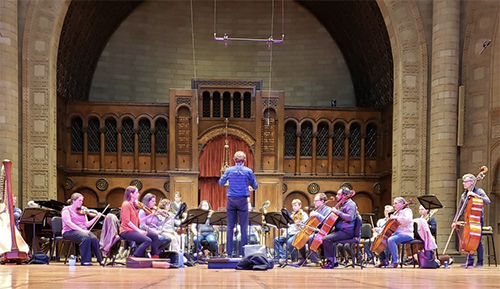by Rory O’Donoghue

The orchestra brought back Weary Toons and Mellow Croons, a 2017 commission from Chicago-based composer Gabriel Novak, for an inspired collaboration with dancers from the Cleveland School of the Arts. The music begins as if stunted, pieces of melody swirling around, seeking a cohesion that somehow eludes them. The orchestra passes these shards back and forth, and they alight in different sections of the ensemble as they head towards unity.
Choreography by Amanda Clark (Part I), Emily Jeffries, and Jalen Black (Part II) was poignantly attentive to the organic development of the music, initially jumbled but slowly achieving form. Part I featured Ania Fuller and Jordan Clark moving expressively in complementary jumpsuits, and Part II showcased Taniya Howard and Samaya Shakir in flowing dresses, harboring a more balletic approach. Although the performance was brief, the dancers imbued Novak’s already intimate writing with glimmering personality, a satisfying pairing.
Not all of the evening’s collaborations worked as symbiotically. Pulitzer Prize-winning composer George Walker’s Abu, set to a poem by James Henry Leigh Hunt, featured the orchestra and two narrators: a baritone as Abu, and a soprano as an angel. Perhaps the Maltz’s reverberant acoustic couldn’t quite handle the piece, or maybe a soundcheck went awry, but the two booming, amplified voices overpowered the orchestra. It was hard to track Walker’s score under those circumstances, but Smith and the orchestra handled the music elegantly. Unfortunately, I arrived late and missed Walker’s Antifonys, which opened the evening.
The orchestra made lovely work of In Memory by Keith Fitch, head of composition at the Cleveland Institute of Music. Written as an homage to Fitch’s late mentor, Frederick Fox, and also to the Sandy Hook shooting, the music coursed along a lyrical line marked by perpetual ascent. It swirled, fluttered along a whirling undercurrent, and arrived at a reverent threnody in the strings. Fibrous texture gave way to a gentle retreat of chimes. Another gem, this one featuring CCS flutist Sean Gabriel, was Julia Perry’s obscure Pastoral for flute septet, which rhapsodically bloomed along a rising melody.
Verb Ballets danced Margi Griebling-Haigh’s Alegrias with inventive finesse. The music is boisterous, rocking between different Sephardic sounds in a tuneful hodgepodge. Michael Escovedo’s tasteful choreography lent a narrative interpretation to the score, mimicking and expanding upon the music.
The dancers began with a sequence of clock-arm movements, and gained momentum amid a florid wash of flute trills. Off-kilter melodies were met with appropriately clunky movements, and graceful moments were highlighted by elegant extensions. The company of nine dancers pared down to a trio dramatizing courtship, two of the parties vying for the affection of the third. The music deals mainly with color, and the dancing filled in the lines artfully to shape the narrative. The dancing spun out into a drunken sprawl before amping up for the raucous drama of the ending, which seemed to paraphrase the previous gestures. Performing in costume but without a set or props, Verb Ballets simply channeled the expression inherent in ballet theater in their memorable rendering of Griebling-Haigh’s work.
Published on ClevelandClassical.com April 24, 2019.
Click here for a printable copy of this article



